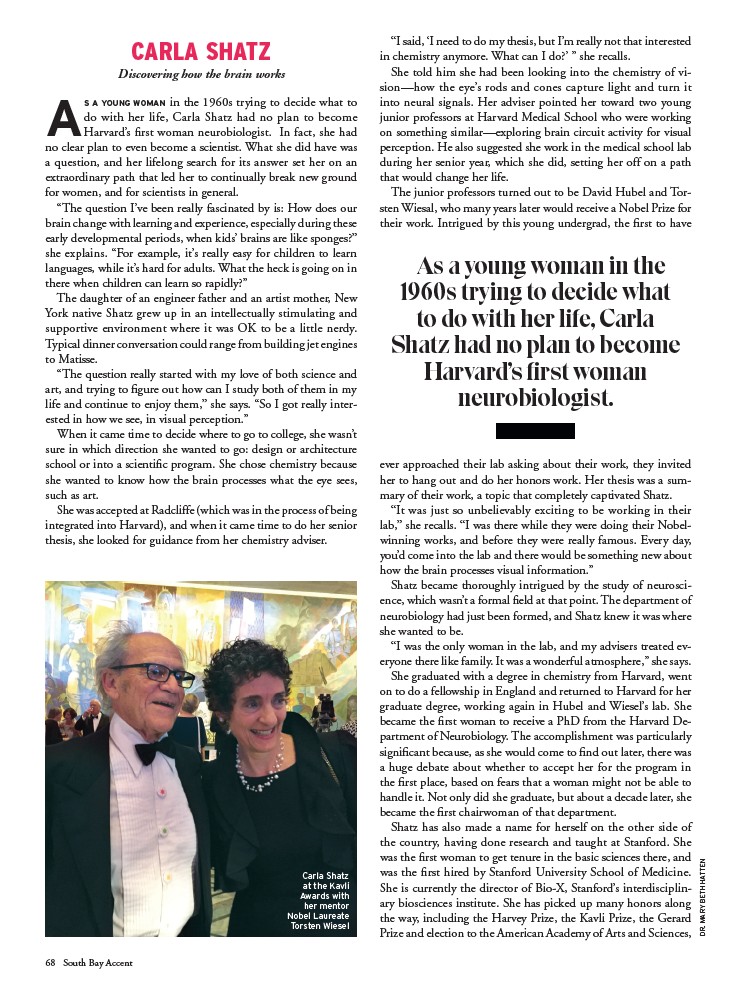
CARLA SHATZ
Discovering how the brain works
AS A YOUNG WOMAN in the 1960s trying to decide what to
do with her life, Carla Shatz had no plan to become
Harvard’s first woman neurobiologist. In fact, she had
no clear plan to even become a scientist. What she did have was
a question, and her lifelong search for its answer set her on an
extraordinary path that led her to continually break new ground
for women, and for scientists in general.
“The question I’ve been really fascinated by is: How does our
brain change with learning and experience, especially during these
early developmental periods, when kids’ brains are like sponges?”
she explains. “For example, it’s really easy for children to learn
languages, while it’s hard for adults. What the heck is going on in
there when children can learn so rapidly?”
The daughter of an engineer father and an artist mother, New
York native Shatz grew up in an intellectually stimulating and
supportive environment where it was OK to be a little nerdy.
Typical dinner conversation could range from building jet engines
to Matisse.
“The question really started with my love of both science and
art, and trying to figure out how can I study both of them in my
life and continue to enjoy them,” she says. “So I got really interested
in how we see, in visual perception.”
When it came time to decide where to go to college, she wasn’t
sure in which direction she wanted to go: design or architecture
school or into a scientific program. She chose chemistry because
she wanted to know how the brain processes what the eye sees,
such as art.
She was accepted at Radcliffe (which was in the process of being
integrated into Harvard), and when it came time to do her senior
thesis, she looked for guidance from her chemistry adviser.
68 South Bay Accent
“I said, ‘I need to do my thesis, but I’m really not that interested
in chemistry anymore. What can I do?’ ” she recalls.
She told him she had been looking into the chemistry of vision—
how the eye’s rods and cones capture light and turn it
into neural signals. Her adviser pointed her toward two young
junior professors at Harvard Medical School who were working
on something similar—exploring brain circuit activity for visual
perception. He also suggested she work in the medical school lab
during her senior year, which she did, setting her off on a path
that would change her life.
The junior professors turned out to be David Hubel and Torsten
Wiesal, who many years later would receive a Nobel Prize for
their work. Intrigued by this young undergrad, the first to have
As a young woman in the
1960s trying to decide what
to do with her life, Carla
Shatz had no plan to become
Harvard’s first woman
neurobiologist.
ever approached their lab asking about their work, they invited
her to hang out and do her honors work. Her thesis was a summary
of their work, a topic that completely captivated Shatz.
“It was just so unbelievably exciting to be working in their
lab,” she recalls. “I was there while they were doing their Nobelwinning
works, and before they were really famous. Every day,
you’d come into the lab and there would be something new about
how the brain processes visual information.”
Shatz became thoroughly intrigued by the study of neuroscience,
which wasn’t a formal field at that point. The department of
neurobiology had just been formed, and Shatz knew it was where
she wanted to be.
“I was the only woman in the lab, and my advisers treated everyone
there like family. It was a wonderful atmosphere,” she says.
She graduated with a degree in chemistry from Harvard, went
on to do a fellowship in England and returned to Harvard for her
graduate degree, working again in Hubel and Wiesel’s lab. She
became the first woman to receive a PhD from the Harvard Department
of Neurobiology. The accomplishment was particularly
significant because, as she would come to find out later, there was
a huge debate about whether to accept her for the program in
the first place, based on fears that a woman might not be able to
handle it. Not only did she graduate, but about a decade later, she
became the first chairwoman of that department.
Shatz has also made a name for herself on the other side of
the country, having done research and taught at Stanford. She
was the first woman to get tenure in the basic sciences there, and
was the first hired by Stanford University School of Medicine.
She is currently the director of Bio-X, Stanford’s interdisciplinary
biosciences institute. She has picked up many honors along
the way, including the Harvey Prize, the Kavli Prize, the Gerard
Prize and election to the American Academy of Arts and Sciences,
Carla Shatz
at the Kavli
Awards with
her mentor
Nobel Laureate
Torsten Wiesel
DR. MARY BETH HATTEN